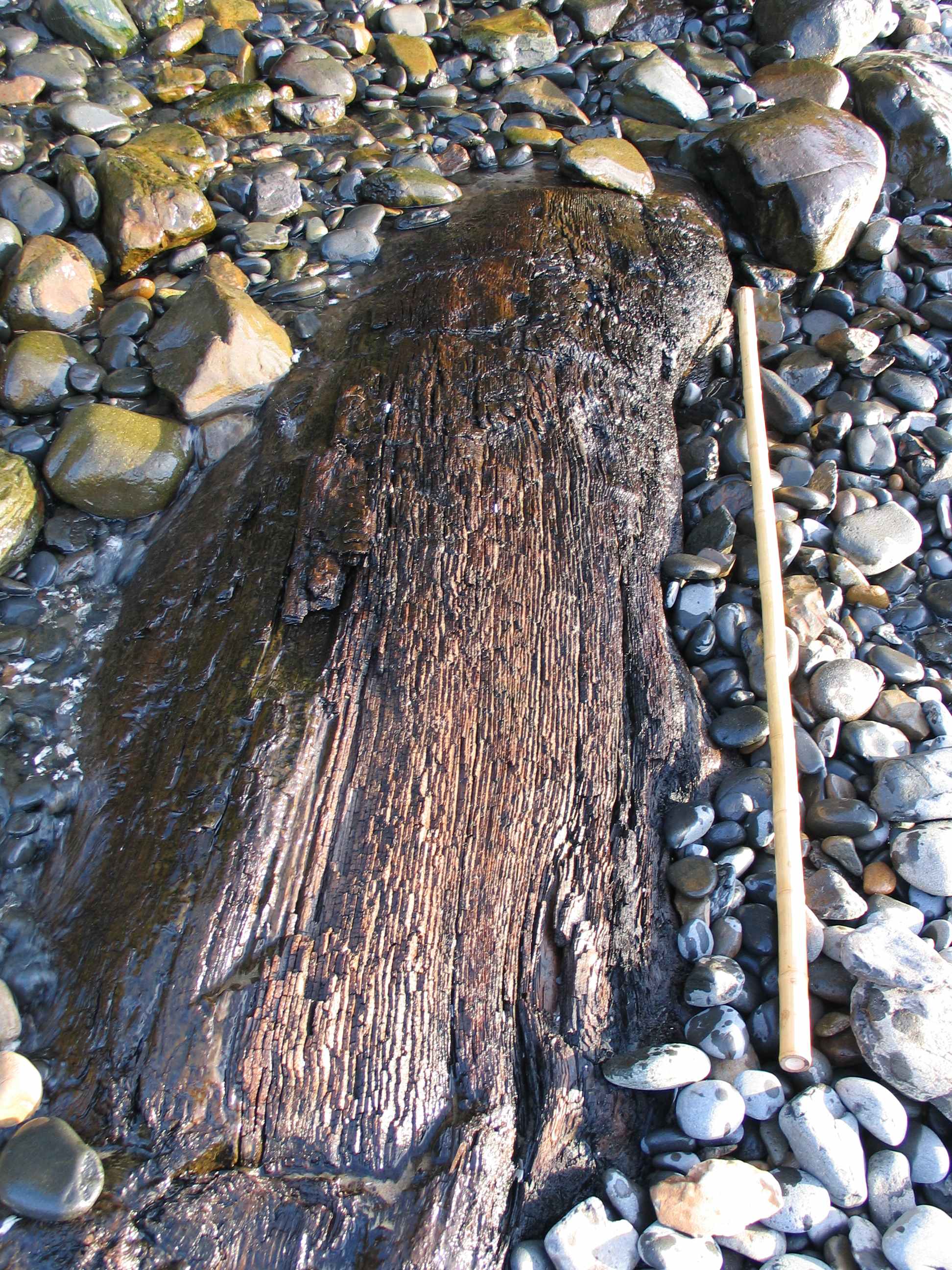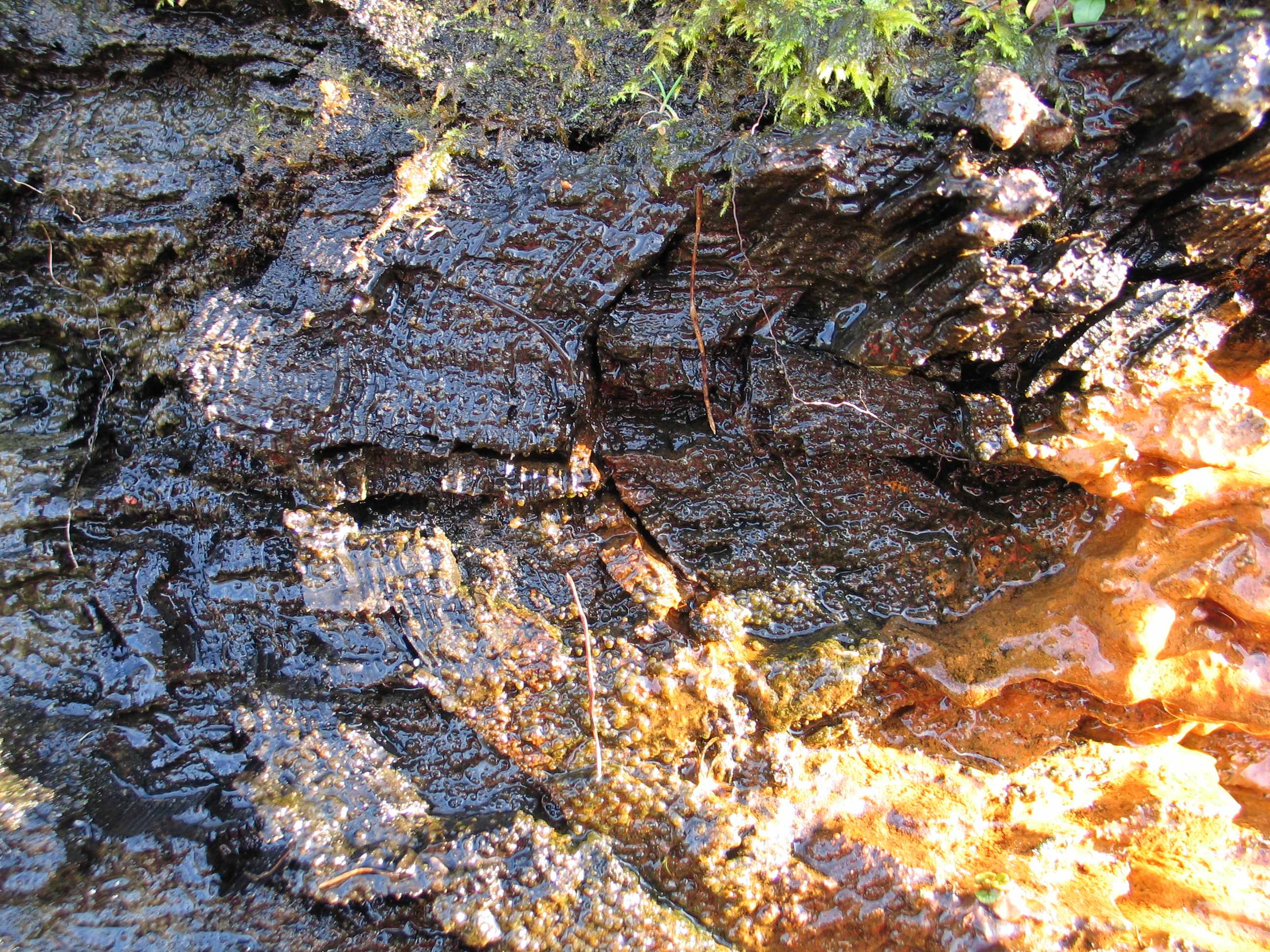 |
Old Trees Make New Appearance

By Stephanie Cartier
Talk about being older than dirt. An ancient forest, buried for tens of thousands of years, has been found on the central Oregon Coast. An Oregon State University (OSU) researcher found the remains buried in a cliff earlier this year, and tests indicate the forest is at least 55,000 years old. To put that in perspective, the last ice age ended only about 10,000 years ago.
Most people in the Pacific Northwest know the pleasure of rambling down the beach in search of shells, agates, and other unknown treasures waiting for them. It's not unusual to see people hunched over in the sand to get a better look at coastal finds. What is unusual is finding a tree sticking out of the side of a cliff. But during a family outing in Yachats, Oregon, Bill Smyth did just that. "We were walking at very low tide–it was spring tide–and getting to places you can't ordinarily get to safely, and the family went on ahead of me and I took a look at this funny-looking exposure at the bottom of a sediment bank.” The funny-looking exposure turned out to be a jaw-dropping discovery.
"What caught my attention was tree trunks and stumps and branches sticking out of the sediment under about 30 feet or so of sedimentary material,” says Smyth, an oceanographer at OSU. "The material above it seemed to be well-mixed; it wasn't in layers as sediments often are, which made it look as if these trees had been buried in a landslide.”
Smyth originally thought the trees might have been interred during a major earthquake that, according to Japanese tsunami records, hit the Pacific Northwest on Jan. 26, 1700. But as a scientist, he wanted to know more. "Being on vacation and having nothing better to do, I got interested in figuring out how the trees came to be in such a strange location.” So he turned to the Internet for some answers. The search led him to Lawrence Livermore Labs, which could do carbon dating to get an idea of just how old these trees are. The results came back a few months later, but weren't what anyone was expecting.
The samples were considered "carbon dead," meaning there wasn't even enough carbon 14 left to measure with even the most precise instruments available. "Which means that the samples died at least 55,000 years ago,” says Smyth. But they could be much, much older. "I eventually picked myself up off the floor and tried to figure out what this meant.”
Smyth turned to colleague Roger Hart, a former OSU oceanographer now working for the Oregon Department of Geology and Mineral Industries for some answers. But that only led to more questions. Hart is currently trying to figure out why the trees are being exposed now. "It looks to me like there has been erosion of the sea cliffs from waves,” Hart said in a statement. "Why? That starts to get into the controversy. There's been at least one study that suggests that the wave height has been increasing, and it could be normal progression from sea levels rising.” But, he added, other studies suggest that the area is getting a pattern of more persistent, stronger winds from the southwest. "That wind intensity and storm frequency have been increasing since about 1948. There's also the possibility that this is related to the Pacific Northwest Decadal Oscillation, a 20-to-25 year cycle of lower pressure in the northern Pacific that induces more wind and storms.”
 |  |
The trees themselves might hold some of the answers. By looking at tree rings, researchers can determine climate variability. In drought years, trees don't grow as much, so the rings are close together. But in years of rainy weather, rings are spread farther apart. By comparing and matching the rings from different trees, scientists can get a good idea of what catastrophic events took place when. OSU dendrochronologist, or tree ring decoder, Bryan Black is now doing the research. He says that by looking at the marks, he is able to estimate how often things like windstorms, fires, and climate changes happen.
Tree ring chronologies are an important part of understanding what changes occurred and help researchers to put dates on events. The climate causes common growth patterns among individual trees, which scientists use to answer some questions. "So what we do is match up all those growth patterns among the trees, more or less match up all those barcodes, and then we know we have all the trees precisely dated among one another,” says Black. "If we have this common growth pattern, then that's usually a very good indicator of climate.”
"The trees, plus the deposits they're entombed in, I think can tell use quite a bit about what the coast was like tens of thousands of years ago. Generally what you're looking at is a time when sea level was much lower, but climate was much colder,” says George Priest, a geologist with the Oregon Department of Geology and Mineral Resources.
And according to Smyth, by being able to tell what climate changes ordinarily occur, researchers could get a better idea of the impact humans have had on global climate changes.
Smyth's find will likely play an important role in understanding ancient weather patterns. "Something on the order of 50,000 years plus is pretty much unheard of, not only in the Northwest, but anywhere in the world,” says Black.
Tree ring chronologies also add to scientists' understanding of ancient earth movements. "If we see several sites that were buried all at the exact same time, up and down the coast, that would be indicative of a very large earthquake event,” says Black.
It's possible to have individual landslides as the result of rainstorms or just random chance, but a lot of trees buried at once point to major seismic events. Such an idea goes against common assumptions about the Northwest. "That of course, is something people have been working hard to sort out in the Pacific Northwest over the last couple of decades. Until then, people thought there were no major earthquakes here, as opposed to, say, California. Now we know that there are; they just aren't very frequent, since there hasn't been one in recorded history,” says Black.
 |  |
But all of this hinges on being able to actually reach the trees. Smyth's find is buried in a cliff, below Highway 101. The researchers are hoping that there is enough wood already exposed to build a tree ring chronology. "We rather doubt that we're going to be able to dig back into the cliffs since they are so unstable,” noted Black. "So it's going to be tricky to harvest this material.” Because all beaches in Oregon are public, accessing the ancient forest also requires government approval. But Black says he hopes to start writing grants this fall and be out as early as this winter to do some sampling. Despite the weather on the coast that time of year, Black says it's the ideal time to sample because waves erode the coastline better in the winter. And the clock is ticking. "The sooner the better so that we don't lose anything to further erosion. This stuff has been exposed rather recently and we don't want it to decompose before we can get to it.”
Erosion can occur more rapidly than some might think. An entire housing development was being built and collapsed recently; no one believed the erosion would happen that fast. "The erosion on the Oregon Coast is kind of an amazing thing. There are places where you can see two bridges on the highway, side by side, because they've had to be replaced so rapidly,” says Smyth.
A lot of work is still left to be done. Researchers plan to try another, newer method using sand to try to date the trees, which is accurate to 145,000 years. "We're very much in the beginning stages of this research,” says Black. But what they could find might fill in a lot of holes for researchers.
The fact that the ancient trees, which have been quietly passing the years as thousands of cars roll over the scenic highway, are just now emerging serves as an important reminder to people who live and work on the beaches of Oregon. "To me, it just emphasizes the importance of studying the geology of the coasts. A larger and larger fraction of our population is living on coasts, and we have to learn how to interact with that sort of environment,” says Smyth. "I do think it helps to make life better for people in those regions.”
Stephanie Cartier, who grew up spending summers on the central Oregon coast, is pursuing a master's degree in technical communication at the University of Washington.
Images:
Top: This wood, recently exposed on the central Oregon Coast, is believed to be more than 50,000 years old.
Miggle: A large wood remnant, buried in ancient soil, is being exposed by wave action.
Bottom: A broken log protrudes from the cliff face. Researchers are using the rings from the ancient logs to understand what was happening when these trees were alive.
Photos: Bryan Black

|
 |
|